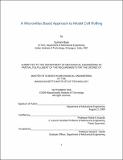| dc.contributor.advisor | Rohit N. Karnik. | en_US |
| dc.contributor.author | Bose, Suman | en_US |
| dc.contributor.other | Massachusetts Institute of Technology. Dept. of Mechanical Engineering. | en_US |
| dc.date.accessioned | 2010-05-25T19:23:26Z | |
| dc.date.available | 2010-05-25T19:23:26Z | |
| dc.date.copyright | 2009 | en_US |
| dc.date.issued | 2009 | en_US |
| dc.identifier.uri | http://hdl.handle.net/1721.1/54881 | |
| dc.description | Thesis (S.M.)--Massachusetts Institute of Technology, Dept. of Mechanical Engineering, 2009. | en_US |
| dc.description | This electronic version was submitted by the student author. The certified thesis is available in the Institute Archives and Special Collections. | en_US |
| dc.description | Cataloged from student submitted PDF version of thesis. | en_US |
| dc.description | Includes bibliographical references (p. 45-50). | en_US |
| dc.description.abstract | Cell rolling is a physiological phenomenon, which allows leukocytes to attach to activated vascular endothelium and reach sites of inflammation. A novel approach to model cell rolling is presented in this thesis. The model incorporates all the aspects known to be important to rolling in a semi-analytical framework making it computationally efficient. Bond kinetics have been used to define microvillus attachment probability which is in turn used to find out the net force on the cell. Deformability is also taken into account by an empirical relation which allows shear modulation of cell-surface contact area. The model showed excellent agreement with experimental results over a wide range of shear stresses. Using the model, the effects of cell deformability and microvillus structure have been studied and its implications discussed. The model was also used to predict rolling of microspheres, which showed reasonable agreement with experiments. Finally, the contribution of different features towards stabilization of rolling was elucidated by simulating different hypothetical cases with contributions from different cellular features. | en_US |
| dc.description.statementofresponsibility | by Suman Bose. | en_US |
| dc.format.extent | 50 p. | en_US |
| dc.language.iso | eng | en_US |
| dc.publisher | Massachusetts Institute of Technology | en_US |
| dc.rights | M.I.T. theses are protected by
copyright. They may be viewed from this source for any purpose, but
reproduction or distribution in any format is prohibited without written
permission. See provided URL for inquiries about permission. | en_US |
| dc.rights.uri | http://dspace.mit.edu/handle/1721.1/7582 | en_US |
| dc.subject | Mechanical Engineering. | en_US |
| dc.title | A microvillus based approach to model cell rolling | en_US |
| dc.type | Thesis | en_US |
| dc.description.degree | S.M. | en_US |
| dc.contributor.department | Massachusetts Institute of Technology. Department of Mechanical Engineering | |
| dc.identifier.oclc | 613213529 | en_US |
